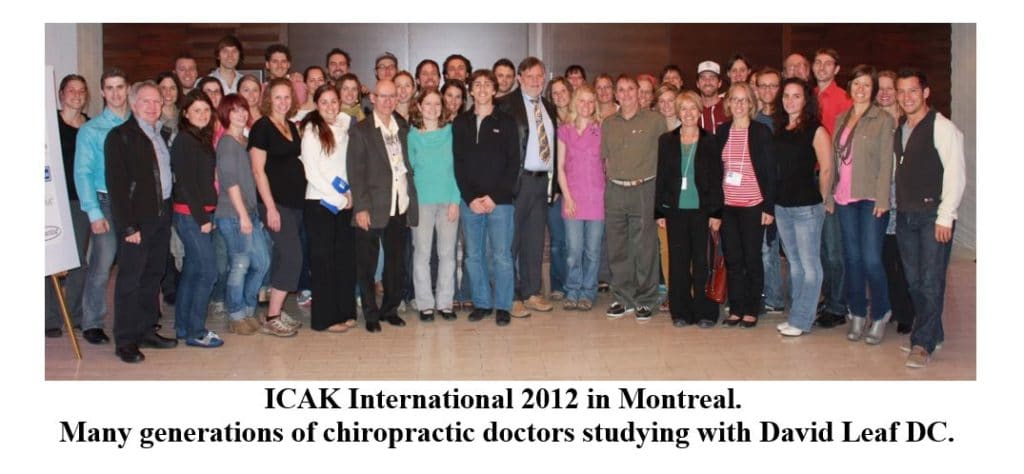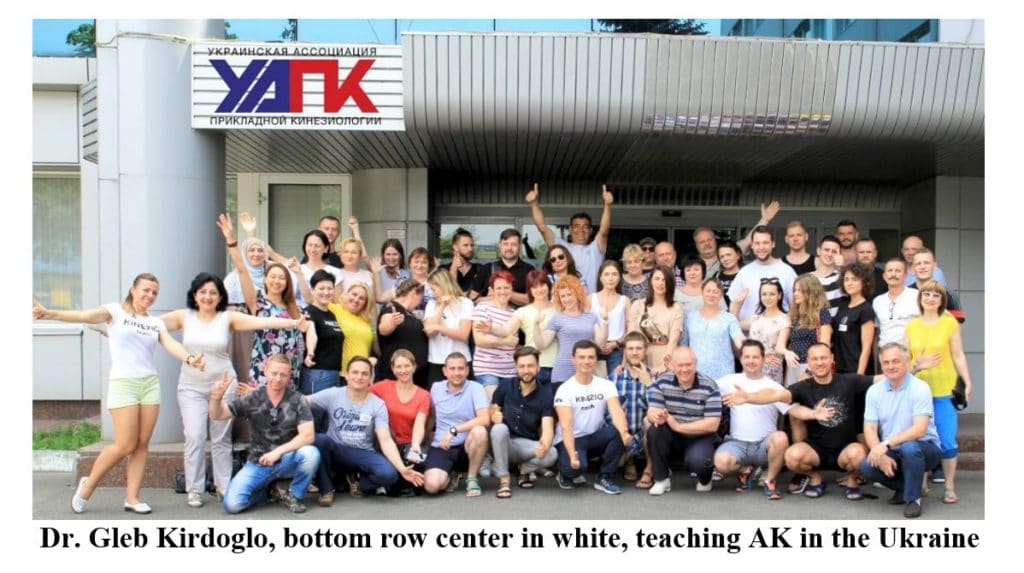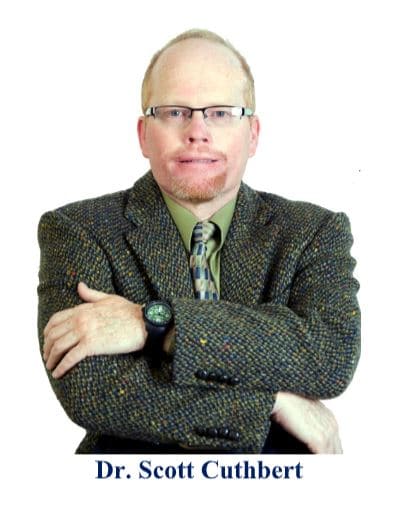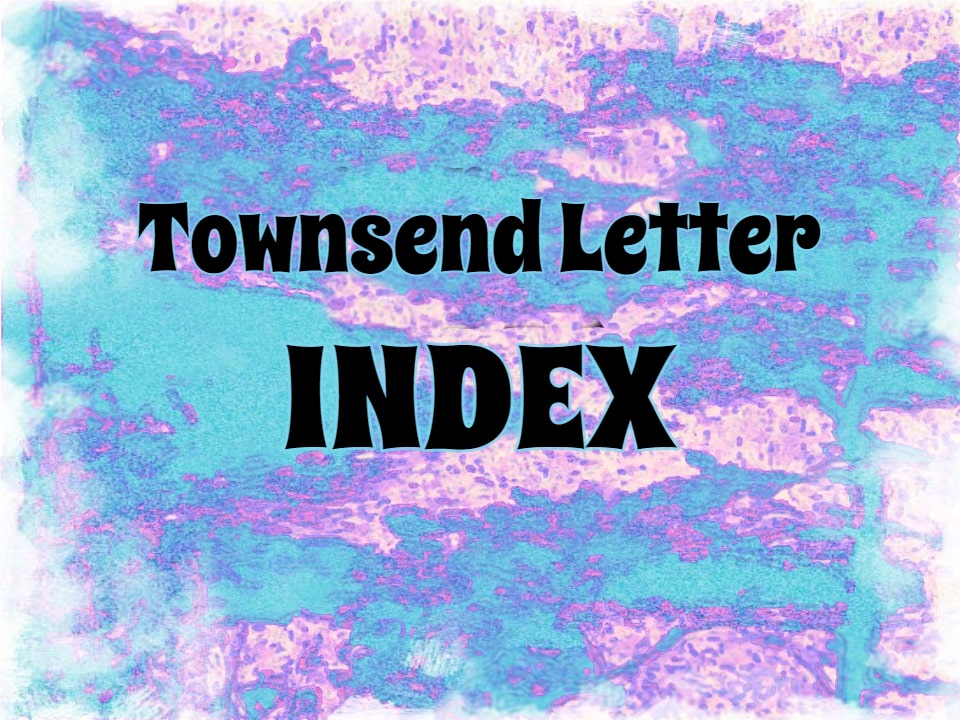…article continued:
The same meeting of 2005 was a milestone in the teaching of AK in Quebec: Dr. Charles Héroux DC, the youngest chiropractor to obtain his DIBAK, began the following year teaching his first 100-hour basic course. Thirteen years later, he now teaches AK in several countries. A few years later, the rest of the “French connection,” a group of motivated young chiropractors who would travel across America to gather relevant information and learn from American chiropractors, also got their DIBAK. Of those, Anne-Eugénie Simard, DC, and Jean-Sébastien Bernier, DC, became teachers. New teachers have been constantly added: François Fortin, DC; Sébastien Houle, MSc, DC; Geneviève Gagné, DC; and Frédéric Rancourt, DC.

In 2011, Jayson Grossman, DC, ND, went to swell the ranks of the Ontario DIBAKs. With his great expertise in teaching, he managed to join both the ND and the DC, bridging between British Columbia and Ontario.
In 2012 the ICAK-International Meeting was held in Montreal. Thanks to our close ties with many of the AK’s greats, an impressive selection of guests was received on stage.
ICAK-Canada today has 98 members, including 20 DIBAK and the first honorary DIBAK received in 2018 by Raymond Cyr, DC.
Applied Kinesiology in Ukraine
Applied kinesiology was first presented in the Ukraine in 2010, when Ukrainian doctors began an active dialogue with their Russian colleagues. The first seminar from Dr. Lyudmila Vasilyeva took place in Yalta (Crimea, Ukraine). Doctors became interested in training in the largest Ukrainian Center for Medical Rehabilitation and Kinesiotherapy called the “Higher League.” In 2012, the head of the Center, orthopedic and traumatologist, Gleb Kirdoglo, MD, PhD, for the first time organized training in AK in mainland Ukraine—in Odessa, where a series of seminars were conducted by teachers from the Moscow Academy with Professor Vasilyeva. The seminars enjoyed a full house, and students came from all over Ukraine and very soon from many other countries. At the same time, Gleb Kirdoglo studied at seminars in Moscow and began to assist Professor Vasilyeva during the training cycles.
In addition to active academic work, the doctors of the Higher League medical center began scientific research work. Using the latest diagnostic equipment, studies were conducted; kinesiology algorithms of assessment and care were tested and assessed. Physiotherapists at the center were developing new kinesiotherapy and rehabilitation approaches for patients with musculoskeletal disorders. Research results have been presented at major scientific conferences in Kyiv and Moscow. Dr. Gleb Kirdoglo received a patent for a method of treating patients with dorsalgia.
In 2012, the Ukrainian Association of Applied Kinesiology and Medical Rehabilitation (UAAK) was created and registered. The organization continues to be actively involved in educational and scientific work, publishing books and teaching aids, and developing training programs. UAAK specialists have begun to conduct international seminars in Europe, Asia, and the Middle East. At the invitation of medical centers and specialized associations, UAAK organizes training cycles in Germany, Estonia, Latvia, Kazakhstan, Moldova, and Israel. The number of students who have attended the training now exceeds 5,000. The president of the Ukrainian association, Dr. Gleb Kirdoglo, initiated the creation of professional AK communities in Kazakhstan and Moldova. In 2019, over 700 specialists from nine countries are members of the UAAK.
In 2019, the European Academy of Natural Sciences presented Dr. Gleb Kirdoglo the Albert Schweitzer Medal for “the development of medical rehabilitation and applied kinesiology in Ukraine and Europe”. This annual award is presented to medical representatives from different countries for their international contributions to the development of various fields of medicine.

Despite the incessant expansion, evolution and redevelopment, much of the original AK approach has stood the test of time and persists in its essentials among the hundreds of thousands of MMT practitioners around the world. The voluntary skeletal muscular system is the source and the recipient of the greatest neural activity in the body; and therefore the AK clinician is one of the most comprehensive “diagnosticians” of human function and malfunction at work in the world today.
Dr. Goodheart and the ICAK have dedicated their lives to the future of integrative healthcare and its realization with applied kinesiology. This passion for functional diagnosis – “diagnose the need, supply the need, observe the result” – for the most unusual and the most common patient problems has been shared at chiropractic, osteopathic, medical, and dental colleges, seminars, and lecture-tours all over North America, Europe, Australia and Asia. Hailed as a friend and inspiration to many, Dr. Goodheart is a man to be remembered, honored, and modeled. The numbers of clinicians and healing professions that are using and developing AK demonstrate that many of the most famous doctors in the orthodox and complementary and alternative medicine world felt that “the Goodheart’s approach” was invaluable because it focused on measurable physical factors, which make up the constellation of dysfunctions affecting the person’s total health picture and happiness.

Dr. Scott Cuthbert practices AK at
Intercare Chiropractic Clinics in Makati Manila.
Dr. Cuthbert is the author of Applied Kinesiology Essentials: The Missing Link in Health Care (2014), and Applied Kinesiology: Clinical Techniques for Lower Body Dysfunctions (2013), and Whiplash Dynamics and Manual Muscle Testing (2019), all of which are available at Amazon Kindle. He has published 15 Index Medicus clinical outcome studies and literature
reviews, and over 50 peer-reviewed articles on AK.
References
- Jensen AM. Estimating the prevalence of use of kinesiology-style manual muscle testing: A survey of educators. Adv Integr Med. (2015).
- Peterson D, Wiese G. Chiropractic: An Illustrated History. St. Louis: Mosby; 1995:387.
- ChiroAccess. Applied Kinesiology Technique: http://www.chiroaccess.com/Articles/Technique-Summary-Applied- Kinesiology.aspx?id=0000144.
- LeBoeuf C. A Survey of Registered Chiropractors Practicing in South Australia in 1986. J Aust Chiro Assoc. 1988:105-10.
- Palmer DD. The chiropractors adjustor: the science, art and philosophy of chiropractic. Portland Printing House: Portland, OR; 1910:7.
- McDowall D, et al. Tone as a health concept: An analysis. Complement Ther Clin Pract. 29, Nov 2017:27-34.
- Bass MJ, Buck C, Turner L, Dickie G, Pratt G, Robinson HC. The physician’s actions and the outcome of illness in family practice. J Fam Pract. 1986;23(1):43-7.
- Schmitt WH, Cuthbert SC. Common errors and clinical guidelines for manual muscle testing: The “arm test” and other inaccurate procedures. Chiropr Osteopat. 2008;16:16.
- Gin RH, Green BN. George Goodheart, Jr., D.C., and a history of applied kinesiology. J Manipulative Physiol Ther. 1997 Jun;20(5):331-7.
- Time Magazine honoree: “Alternative Medicine Innovators”; 2000.
- Owens C. An Endocrine Interpretation of Chapman’s Reflexes, 2nd edition. Newark, OH: American Academy of Osteopathy. 1937; Preface.
- International College of Applied Kinesiology, Deutschland. http://www.icak-d.de/.
- Cuthbert S, Markham B, Blaich R. David S. Walther, DC, DIBAK: Scholar, Researcher, Politician and Teacher. Chiropractic History. 33(1): Summer 2013.
- C. Perot, F. Goubel, R. Meldener. Quantification de l’inhibition de la force muscul aire suite a l’application d’une manoeuvre chiropractique. Journal de Biophysique et de Biomécanique. 1986; Volume 10, Supplément au N°1.
- In English: C.Perot, R.Meldener, F.Goubel, 1991, Objective measurement of Pro prioceptive Technique Consequences on Muscular Maximum Voluntary Contraction du ring Manual Muscle Testing. Agressologie; 1991.
- Gerz W. Lehrbuch der Applied Kinesiology (AK) in der naturheilkundlichen Praxis. (in German). AKSE-Verlag, Munchen; 2001.
- Garten H. Applied Kinesiology, der Lehrfilm. 1996, München: Video Commerz.
- Garten H. Applied Kinesiology, Muskelfunktion, Dysfunktion und Therapie. 2 ed. 2012, München: Urban&Fischer, Elsevier.
- Garten H, Weiss G. Systemische Störungen – Problemfälle lösen mit Applied Kinesiology. 2007, Urban und Fischer: München.
- Burtscher E, et al. AK-Meridiantherapie (AKMT). 2001, AKSE: Wörthsee.
- Garten H. Lehrbuch Applied Kinesiology Muskelfunktion- Dysfunction-Therapie. (in German) Urban & Fischer, Munich; 2004.
- Gerz W. Applied Kinesiology in der naturheilkundlichen Praxis. 2000, AKSE-Verlag: Wörthsee.
- Garten H. Das Muskeltestbuch. München: Urban & Fischer; 2007.
- Ramsak I, Gerz W. AK-Muskeltests auf einen Blick. 2 ed. 2004, Wörthsee: AKSE.
- Ramsak I. Handbuch der AK-Muskeltests. 2007, Wien: Verlagshaus der Ärzte
- Lines D, McMillan A, Spehr G. Effects of Soft Tissue Technique and Chapman’s Neurolymphatic Reflex Stimulation on Respiratory Function. J Aust Chiro Assoc. 1990 Mar; 20 (1): 17-22.
- McDowall D. The growth of Applied Kinesiology education. Thesis paper, RMIT University.





